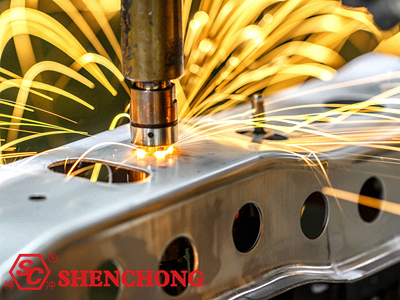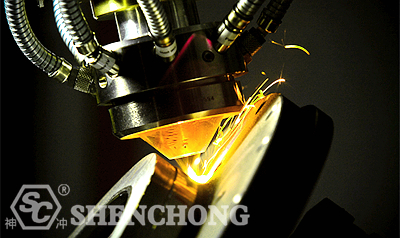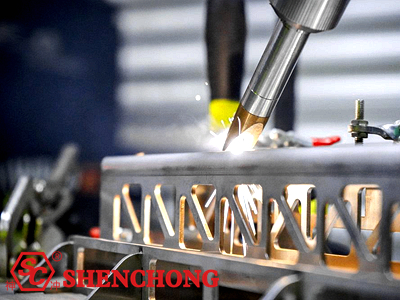
With the development of science and technology, sheet metal laser welding technology has appeared in recent years. So what is laser welding? What are the characteristics and advantages of laser welding?

The below diagram shows laser welding working principle:
First, what is a laser? The world's first laser beam was produced in 1960, which by using a flash bulb to excite ruby crystal grains.
Due to the limitation of the crystal heat capacity, it could only produce a very short pulse beam with very low frequency. Although the instantaneous pulse peak energy up to 106W, it is still a low energy output.

1) Fast speed, large depth and small deformation.
2) Laser welding can be welded at room temperature or under special conditions.
3) when a laser passes through an electromagnetic area, the beam will not deflect; the laser can be welded in vacuum, air and certain gas environments, which also can be welded through glass or materials that are transparent to the beam.
4) Laser welding machine can weld refractory materials such as titanium, quartz, etc., and can also weld heterogeneous materials with good results.
5) After the laser focusing, the power density very high. When welding by high power, the aspect ration can reach 5:1, even up to 10:1.
6) Laser welding can do micro welding. The laser beam after being focused can obtain a very small spot and can be positioned accurately. It can be used in the assembly welding of micro and small workpieces for automated production.
7) Laser welding machine can weld inaccessible parts or implement non-contact remote welding, which has great flexibility.
8) The laser beam can easily split the beam in time and space, can perform multi-beam simultaneous processing and multi-station processing, providing conditions for more precise welding.
9) For laser welding, we need the assembly workpiece with high precision, and the position of the beam on the workpiece must not be significantly offset. This is because the spot size after laser focusing is small and the welding seam is narrow, so filler metal materials are added. If the workpiece assembly accuracy or beam positioning accuracy does not meet the requirements, it is easy to cause welding defects.
10) The cost of laser welding is relatively high, resulting in a large one-time investment.

Power density is one of the most important parameters in laser processing. For example, we use a higher power density, the surface layer can be heated to the boiling point within a microsecond time range, resulting in a large amount of vaporization. Therefore, high power density is beneficial for material removal processes such as drilling, cutting, and engraving.
For lower power densities, it takes several milliseconds for the surface temperature to reach the boiling point. Before the surface layer vaporizes, the bottom layer reaches the melting point, making it easy to form a good molten weld. Therefore, in conductive laser welding, the power density is in the range of 104~106W/cm2.
Laser pulse waveform is important in laser welding technology, especially for thin sheet welding. When a high-intensity laser beam hits the surface of material, 60 to 98% of the laser energy will be reflected and lost on the metal surface, and the reflectivity changes with the surface temperature. During the action of a laser pulse, the metal reflectivity changes greatly.
Pulse width is one of the important parameters of pulse laser welding. It is not only an important parameter different from material removal and material melting, but also can determine the cost and volume of processing equipment.
Because the power density at the spot center of the laser focus is too high, it is easy to evaporate into holes.
On each plane away from the laser focus, the power density distribution is relatively uniform. There are two defocus modes: positive defocus and negative defocus. When the focal plane is above the workpiece, it is positive defocus. Otherwise, it is negative defocus.
According to geometric optics theory, when the distance between the positive and negative defocus planes and the welding plane is equal, the power density on the corresponding planes is approximately the same. But in fact the shape of the molten pool obtained is different. When negative defocus, we can get a greater penetration depth, which is related to the molten pool formation process.
Sheet metal laser welding technology is widely used in the manufacturing industry, powder metallurgy, automotive industry, electronics industry and other fields.
At present, the German Volkswagen Company uses laser welding on the roofs of AudiA6, GolfA4, Passat and other brands. BMW and General Motors also use laser welding on the top of the vehicle frame. The German Mercedes-Benz Company uses laser welding for transmission components.
In addition to laser welding technology, other laser technologies have also been widely used: Volkswagen, General Motors, Mercedes-Benz, and Nissan have used laser technology to cut covering parts, Fiat and Toyota have used laser coating for engine exhaust valves, and Volkswagen has performs laser surface hardening on engine camshafts.
Related information about laser welding:
10 Laser Welding Problems and Solutions
Performance Characteristics And Functions Of Sheet Metal Welding Production Line